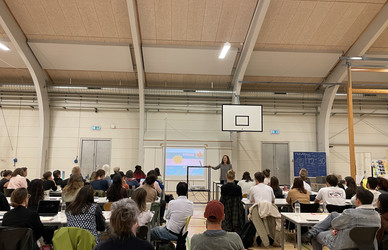"I think we should challenge
the digital media"
But according to Jane Harris, Professor at Kingston University in London, textile designers should value their sense of craftsmanship when approaching the use of creative computing:
”Students of today should be able to interrogate what they’re doing. In that sense, I believe it’s a very underestimated skill to know code. I’m very impressed by the new Hacker Lab as a hub facility at Kolding. Design students are often best equipped to interrogate what they’re doing digitally, after acquiring physical making and material skills,” the Professor explains, when we meet her at the office of her Kolding colleague, Associate Professor and PhD Vibeke Riisberg.
Pioneers in computing
The two women together represent a large part of the pioneer research done in the field of digital textile design that evolved in the early 90’s. ”Many people thought I was mad, when I decided to do a PhD exploring the potential application of computing in a broadly textile context,” Jane Harris states: “There was very little evidence to suggest that 3D computer imaging could equal the aesthetic sensibility of the physical materials I already worked with, let alone present something new”
Back then research study was one of the few ways to access emerging computer tooling, simply due to their huge cost. The Professor acknowledges that naivety drove her through the first steps into the unexplored. A very strong intuition guided the research, though: ”What I mostly made were some visual prototypes. I understood what it would be possible to make, but it was actually not until the last year of my PhD that the appropriate software became accessible.”
Ask questions about your tools
At that time, being a textile designer meant having a purely material background with no IT skills whatsoever. According to Jane Harris this technological ignorance, paradoxically, gave an investigative advantage: “My background was not technical, however I interrogated everything that was technically emerging,” the professor reflects and puts forward another advantage of building your approach on material heritage:
“The instant nature of computing didn’t exist in those days. Time and patience were key components of every digital task. If you wanted to change the colour of an image, it could take hours depending on the level of hardware you were working with. It was often long and laborious but the waiting time also allowed time for consideration of different and experimental forms of working. That value is somehow lost nowadays where all changes can be done almost immediately.” The professor therefore encourages students to use the new technologies with a much more anarchistic approach:
“I very much recommend using open source tools, for example Casey Reas’ processing.org It’s created so you can adapt your own tools. I believe computer graphic imaging hasn’t reached its full potential yet. Commercial software-companies dominate digital development but we should review the tooling so it also meets the design industry’s needs. You should remember, we are only 10-15 years into the use of accessible creative computing processes, a discipline which will be around for many decades to come”




